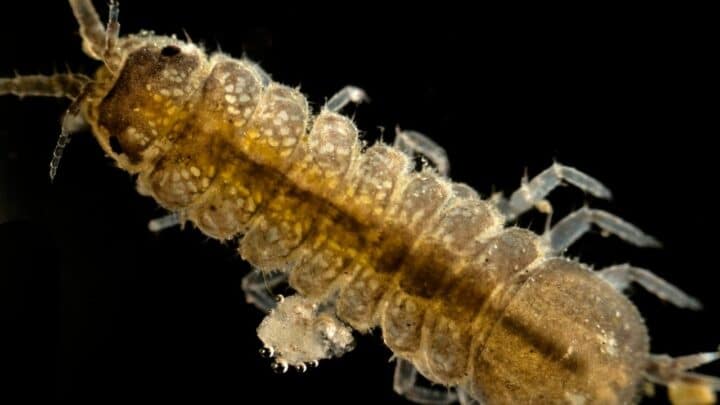Aquatic isopods are a species of Isopoda found in both bodies of freshwater and saltwater. Approximately, 10,000 isopod types are spread out across the planet.
Half of these are aquatic. While they might be the same species, they don’t all look the same.
With 300 million years to continue their evolutionary development, aquatic isopods are a fascinating species.
Aquatic Isopods
Aquatic isopods are classified as arthropods. While that may sound like an insect, aquatic isopods are far closer in relation to crustaceans. They’re scavengers, omnivores, and herbivores and some consume live prey.
How Aquatic Isopods Evolved
With a fossil record of 300 million years, aquatic isopods have evolved significantly. The earlier aquatic isopods were short-tailed isopods.
These isopods resided and developed in shallow bodies of water.
Short-tail isopods were mostly sedentary, latching on to other animals or finding protection in plants. Plantlife helped protect them against falling prey to fish that lived in the same waters.
When they did swim, it was only for shorter lengths at a slow speed.
Around the time that Pangea broke off to form our continents, long-tailed isopods developed. Long-tailed isopods are able to swim faster and are very agile swimmers.
Being able to escape prey at quicker rates meant that they could swim longer distances.
The giant isopods are one of the most interesting species of isopods. These isopods evolved to adapt to deeper environments.
Deep ocean species have always held somewhat of a mystery about them. It is thought that the giant isopod reaches such a large size as to increase its gill size.
The deeper you descend into the ocean, the more oxygen you’re going to need to combat the increasing pressure. Having a larger body, giant isopods have a greater capacity for oxygen.
Aquatic isopods eventually evolved to break off into two separate classifications; aquatic and terrestrial isopods.
Terrestrial isopods adapted to a lower oxygen intake. The terrestrial isopods we see on land still have sets of gills. This leads them to being found in damp and dark places.
What Aquatic Isopods Look Like
Aquatic isopods today have three eyes, a mouth part, and two antennas attached to their head. They have a thorax which is connected to an abdomen with multiple pairs of legs.
Their leg number depends on the isopod type and size.
They breathe through sets of gills on either side. Their hard exoskeleton and flat shape make for an effective defense method.
When threatened, the isopod will curl into a ball. As long as they are up against a predator that is not larger than them, this tactic provides great protection.
Where Aquatic Isopods are Found
Very simply put, aquatic isopods are found in most bodies of water. They can live in freshwaters and in the sea and may go unnoticed depending on their size.
You’ll find in the deeper parts of the ocean larger aquatic isopods. They’re usually found at depths of 500 to over 700 feet.
There are aquatic isopods that live close to shorelines. Sand fleas or sand lice are the most common aquatic isopod types.
These aquatic isopods reside in shallow areas and often can be found burrowed in the wet sand.
What Aquatic Isopods Eat
Aquatic isopods are herbivores, omnivores, and scavengers. They love eating decomposing plants and animals.
Some types of aquatic isopods will latch on to a live host to feed. These isopods will latch onto fish and are usually seen by fishermen attached to the mouth of the fish.
They will also cling onto the bodies of water mammals.
The largest isopod, the giant isopod, which lives deep in the ocean, has been observed eating small fish that are still living.
How Often Do Aquatic Isopods Eat
Aquatic isopods function in a fashion where they can almost hibernate. When they have a meal, they go all out.
As they are not aggressive foodwise, they often feed together. They operate on a level where they move around a circus, consuming everything but the bones.
Isopods can break down anything from fish up to whales. After eating to the point of being overfull, they can go for days without eating again.
Frequently Asked Questions About Aquatic Isopods
Are Aquatic Isopods Dangerous?
Aquatic isopods are not dangerous to humans. These isopods can, however, bite. Due to the size, shape, and configuration of their mouth, if you were to get a bit it would be very minimal.
Can You Eat Aquatic Isopods?
Isopods are indeed edible. They are not poisonous creatures. They have a flavor, unsurprisingly, that is similar to crab or lobster. Giant isopods are typically consumed in Asian countries.
Can You Have Aquatic Isopods As Pets?
Freshwater isopods can make a great addition to an aquarium. They are low maintenance and, as they are not aggressive, they fit well in an active aquarium environment. An added bonus is they can assist in keeping the tank clean as they feed on decomposing organic materials.
In Conclusion
With over 4,000 aquatic isopods, it is safe to say that the species exhibits several different and unique qualities. Developed over time, aquatic isopods are an essential part of the ocean ecosystem.
They break down organic decomposing material, effectively working like little cleaners for the planet’s bodies of water.
Especially when it comes to species of isopods that reside in deeper water, the continued education about these species is fascinating.


